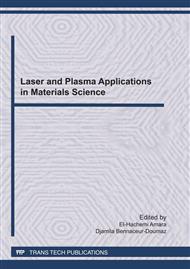p.160
p.164
p.168
p.173
p.177
p.181
p.185
p.189
p.195
Study of API 5L X52 Carbon Steel Treated in Oxygen Plasma Discharge
Abstract:
Oxidation in oxygen plasma of API 5L X52 carbon steel samples was realized in glow electric discharge, under primary vacuum of 8.10-2 torr for a period of 50 hours, under tension discharge of -1000 V and a sample current of 15 mA. The treated steel samples have been characterized through microscopic observations; optical microscopy and Scanning Electronic Microscopy (SEM) coupled with Energy Dispersive Spectroscopy (EDS) microanalysis. These observations permit to reveal microstructural modifications arising from the treatment in oxygen plasma discharge. X Rays Diffraction (XRD) investigation has been realized for the crystallographic characterization of surface modification. The steel samples submitted to the glow discharge show a good surface aspect, with blue black color. Microscopic observations of samples at different stages of treatment, show structural modifications of steel’s surface. SEM observations show surface morphology changes after treatment, and EDS analysis reveal an oxygen implantation within the steel. XRD investigation shows the formation of an iron oxide (Fe2O3) on the surface of the steel specimens after treatment.
Info:
Periodical:
Pages:
177-180
Citation:
Online since:
April 2011
Authors:
Price:
Сopyright:
© 2011 Trans Tech Publications Ltd. All Rights Reserved
Share:
Citation:


